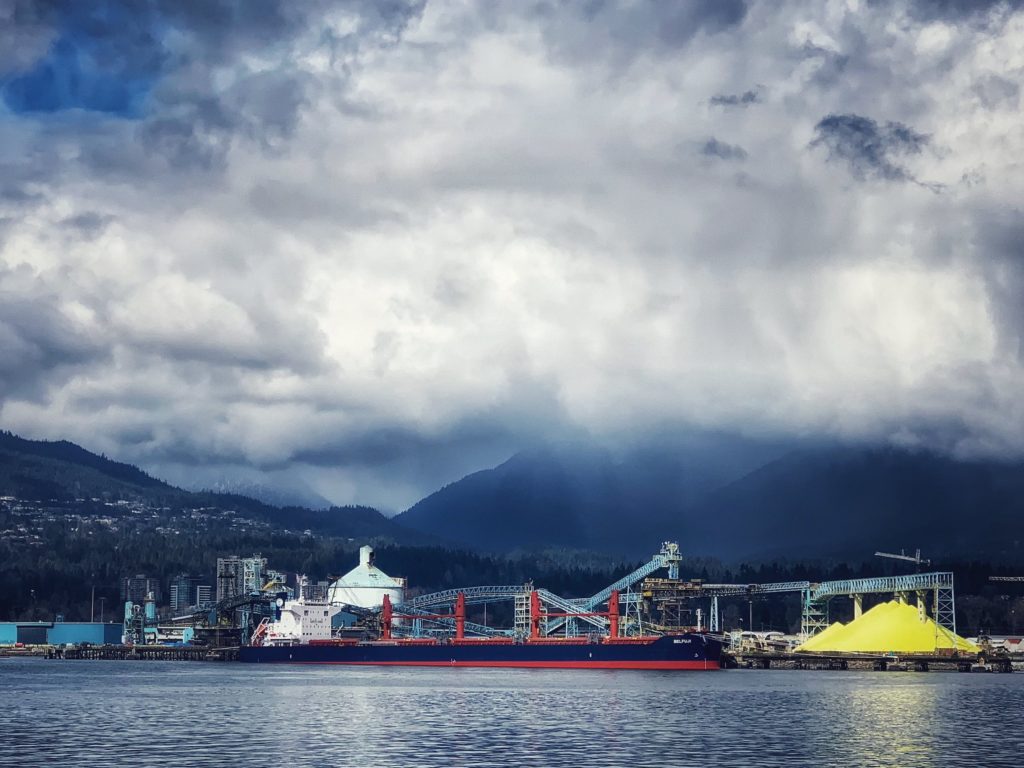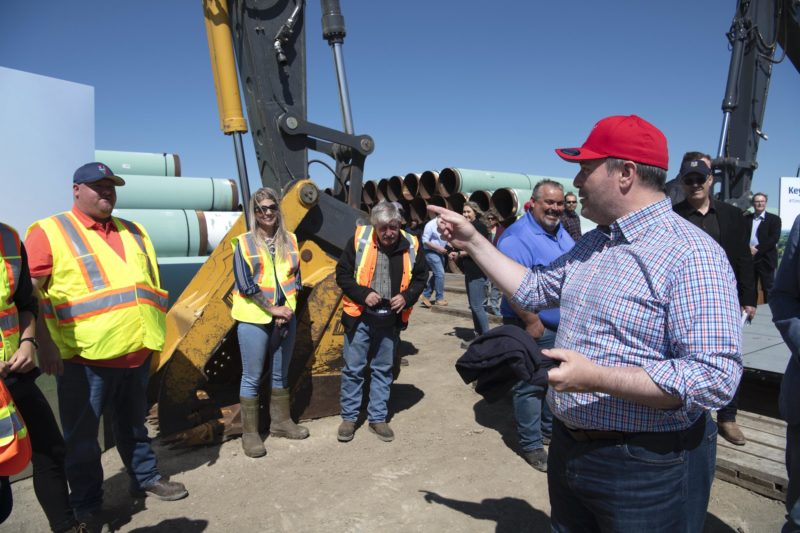
Hope for a huge, ancient and imperilled fish
First Nations are leading efforts to make sure lake sturgeon can find a home in...
Even as calls abound for a green economic recovery from the COVID-19 pandemic, construction is underway on major new pipelines in B.C. and Alberta to carry diluted bitumen and natural gas to international markets.
For experts who say the world is already moving too slowly to avoid catastrophic climate change the decision to build new pipelines is a pressing concern. But for Alberta’s oil industry, which has felt the pinch from a lack of pipeline capacity for years, new construction offers hope for better prices down the road.
The federal government, meanwhile, continues to insist that Canada can have both a strong oil and gas industry and meet its climate targets.
In comments to The Globe and Mail in July 2020, Canada’s Natural Resources Minister Seamus O’Regan said, “I am very serious about combatting climate change and I’m very serious about net zero, and that means we need to make sure we have a prosperous, innovative, healthy oil and gas industry.”
Despite ongoing uncertainty about major pipelines south of the border and opposition to projects such as the Trans Mountain pipeline in Canada, O’Regan said the federal government is pushing for both Keystone XL and Enbridge’s Line 3 replacement to move forward.
On Trans Mountain, he told The Globe: “It’s getting built.”
However, the prospect of new oil and gas infrastructure could pose a major challenge for reducing greenhouse gas emissions, as major investments in pipeline projects signal a commitment to oilsands production for years to come.
“I’m very worried,” said Juan Moreno-Cruz, a Canada Research Chair in energy transitions based at the University of Waterloo, who pointed to a 2019 analysis in the journal Nature that found existing fossil fuel energy infrastructure has already put the world’s ability to limit warming to 1.5 C at risk.
“Every time you do something new, something as monumental as these pipelines, you are delaying that and increasing the chances that we’re just not going to be able to achieve the climate goals we need to,” Moreno-Cruz said.
In its World Energy Outlook 2020, the International Energy Agency projects demand for oil will recover from its “historic drop in 2020” by 2023, but expects demand will plateau after 2030 based on policies currently in place and an assumption that the pandemic is under control next year.
In a scenario where countries are pursuing net-zero emissions by 2050, the International Energy Agency projects demand for oil will fall over the next decade as demand for renewable energy increases.
Richard Masson, an executive fellow at the University of Calgary and chair of the World Petroleum Council, said he believes the oilsands will play a part in providing fuels for transportation and feedstock for petrochemicals for decades to come.
“There are really very limited choices for transportation fuel. Electricity doesn’t work for jets and trains and planes. And even for cars, electric vehicles are a tiny share of the market and it’s going to be a long time before they take a meaningful share of the market,” he said.
New pipelines will help ensure Alberta producers aren’t forced to sell their product at a discount, Masson added.
Several factors have contributed to the lower prices for Alberta crude, according to Masson. Looking back to 2018, there wasn’t enough pipeline capacity to carry all the oil that was being produced in Alberta to refineries, causing a glut in the province. In addition, a number of the U.S. midwest refineries that usually take in Alberta oil were undergoing repairs, so there was less demand for the raw product (leaving producers to send their oil to refineries that were less efficient at processing heavy oil).
“That just resulted in this huge blowout in prices,” said Masson.
In response, the Alberta government brought in curtailment, restricting the amount of oil produced in the province, he explained.
This year, as demand dropped due to COVID-19, producers voluntarily cut production, but Masson said, it won’t be long before demand climbs back up and pipeline capacity becomes an issue once again.
Beyond the risks of ongoing reliance on fossil fuels affecting climate change, there are significant concerns about the local environmental threat posed by some of the major pipeline projects currently under construction.
The devastating consequences of a diluted bitumen spill in the Salish Sea, for instance, is a major concern for some coastal First Nations who oppose the Trans Mountain pipeline expansion.
Cynthia Callison, a founding partner of the Vancouver law firm Callison & Hanna and a member of the Tahltan Nation in northwest B.C., said those underlying reasons — the risk of irreparable harm to traditional territories — are critical for understanding why many Indigenous people haven’t consented to the project.
“For Indigenous people, they believe that the risks are too high, that they’re too great, that there is no way to mitigate any leak especially around important waterways,” Callison said.
She pointed to the potentially devastating impacts of an oil spill in the Fraser River, a major salmon-bearing river many First Nations rely on for both food and the survival of their cultural practices.
Despite the risks, construction is underway on major pipelines in Canada. Here’s the status of four key projects.

The Trans Mountain expansion would lead to a major spike in tanker traffic in the Burrard Inlet. Photo: Edna Winti / Flickr
Construction of the controversial 1,150-kilometre Trans Mountain pipeline, which will increase pipeline capacity from 300,000 to 890,000 barrels per day and result in a sevenfold increase in tanker traffic to the Westridge Marine Terminal in Burnaby, B.C., is underway in both B.C. and Alberta.
Trans Mountain Corporation said in early September that construction in the Edmonton area is nearly done. Construction of the pipeline and pump stations was ongoing in the Yellowhead region of Alberta as of late August.
In B.C., meanwhile, Trans Mountain contractor Surerus Murphy Joint Venture laid the first section of pipe in Kamloops in late September and Trans Mountain said pipeline construction is expected to begin along the Lower Mainland route in the coming months. The route between Surrey and Burnaby has already been approved by the Canada Energy Regulator, but just 3.5 per cent of the route through the Fraser Valley has been approved so far.
Construction is ongoing at the Westridge Marine Terminal in the Lower Mainland, where 60 of 162 piles have been installed so far, according to a September update. Two of the three new births are expected to be open by December 2022.
The cost of the pipeline expansion, which alongside the existing pipeline is now owned by a federal Crown corporation, has ballooned from an estimated $7.4 billion to $12.6 billion.
The project continues to face opposition in B.C. from some First Nations and environmental groups deeply concerned about the threat it poses to lands and waters.
In an Oct. 19 open letter to the CEOs of finance and insurance companies, a group of Indigenous women and organizations called on the institutions to stop financing, investing and insuring projects related to the oilsands.
“The tar sands sector poses grave threats to Indigenous rights, cultural survival, local waterways and environments, the global climate, and public health,” the letter says.
Earlier in October, five people, including a Secwepemc Nation Hereditary Chief and his daughter, were arrested while protesting Trans Mountain near a worksite in Kamloops.
Opponents of the project were dealt a loss this summer when the Supreme Court of Canada refused to hear an appeal of a lower court decision denying an application for judicial review of the Trans Mountain expansion approval from three affected First Nations. But legal experts say there may be other avenues First Nations opposed to the project can pursue.
Callison said First Nations could still make an international complaint through the United Nations that Canada has failed to respect Indigenous rights.
Such a complaint could have a powerful effect, she said. Canada doesn’t “want to lose face, they don’t want to be seen as not respecting the legal rights of Indigenous people,” Callison said.
“So when there is a human rights body that condemns Canada for failing to protect those rights, they do take action, or they have in the past.”
The economic case for the project has also been questioned, most recently by earth scientist David Hughes in an October report for the Canadian Centre for Policy Alternatives.
According to the federal government, it’s estimated that the Trans Mountain expansion will increase revenues for producers by $73 billion over 20 years and increase government revenues by $46 billion through the construction and first two decades of operation.
“TMX will also help strengthen Canada’s advantage as a secure and stable global supplier of oil — now and in the future — while generating the revenues to fund its transition to a low-carbon future,” the federal government says on a website detailing the project’s economic benefits.
Hughes writes that between revised production forecasts, announced expansions and optimizations of other existing pipelines, including Enbridge’s Line 3, and the decline in oil demand driven by COVID-19, there’s no need for additional pipeline capacity from the Trans Mountain expansion.
He also questions the potential for exports to Asia to improve prices for Canadian oil producers, given current prices and higher transport costs.
“The $12.6 billion the government plans to spend on the construction of TMX is counterproductive, as it is unlikely to increase the profits of Canadian producers or result in a revenue stream that will both cover the construction costs and provide additional funds to reduce emissions in a meaningful timeframe,” he writes.
“If anything, TMX will exacerbate the emissions problem by incentivizing additional production growth while diverting funds that could otherwise be spent on actual emissions reduction.”

Unist’ot’en spokesperson and camp founder Freda Huson in the foreground as the RCMP enforce a Coastal GasLink injunction in February 2020. Photo: Amber Bracken / The Narwhal
A linchpin of B.C.’s burgeoning liquefied natural gas industry, the roughly 670-kilometre Coastal GasLink pipeline will carry natural gas from northeast B.C. to Kitimat, where it will be liquefied for transport overseas. The pipeline is expected to begin operating in 2023.
The $6.6 billion pipeline, owned by TC Energy, is strongly opposed by the Wet’suwet’en Hereditary Chiefs and their supporters. There are significant concerns that pipeline construction could harm protected wetlands, erase cultural history and pose a safety threat to Indigenous women as a result of worker camps.
Despite these concerns, construction has moved forward and almost 3,500 people were working along the pipeline right-of-way in October, the company said in a construction update. Grading is underway in four of the eight pipeline segments to prepare the land for pipe installation.
Twenty-one per cent of the pipeline is already installed in northeast B.C. along the first route segment, which runs from west of Dawson Creek to south of Chetwynd. Pipe is also being installed at the LNG Canada connector site near Kitimat.

Map of the Coastal GasLink pipeline. Map: Carol Linnitt / The Narwhal
The Coastal GasLink project has faced considerable opposition from Wet’suwet’en Hereditary Chiefs and their supporters. In February, RCMP arrested more than two dozen people, including Unist’ot’en matriarchs at the Unist’ot’en Healing Centre, as they moved to enforce a court injunction aimed at preventing land defenders from blocking Coastal GasLink’s access to worksites. Protests, including rail blockades, sprung up across the country in support of the Wet’suwet’en.
Lawyers for the Office of the Wet’suwet’en appeared in court in October, asking the B.C. Supreme Court to quash the recent extension of Coastal GasLink’s environmental assessment certificate by the Environmental Assessment Office, the Canadian Press reported.
While the province argued the judicial review is unwarranted, lawyers for the Office of the Wet’suwet’en argued further consideration is needed to determine the project’s potential risks to Indigenous women and girls. The lawyers also raised concerns about TC Energy’s track record of non-compliance with existing environmental conditions, according to the Canadian Press.
Read more: How the Wet’suwet’en crisis could have played out differently
Construction of the Canadian portion of the Keystone XL pipeline has been halted after U.S. President Joe Biden used his first day in office to sign an executive order cancelling a permit for the project.
The move dealt a blow to the planned 1,947-kilometre pipeline, which would ship 830,000 barrels a day of crude oil from Hardisty, Alta., to Steele City, Nebraska, where the crude would enter existing pipes en route to refineries on the Gulf Coast. The pipeline was expected to be in service by 2023.
Natural Resources Minister O’Regan has said the federal government is “intent on getting it done” and Prime Minister Justin Trudeau responded to the Biden permit cancellation by vowing to fight to save the project.
Alberta, meanwhile, bet $1.5 billion dollars on the project moving forward. Premier Jason Kenney’s United Conservative Party government announced a $1.5 billion investment in TC Energy through stocks, as well as a $6 billion loan guarantee in 2021 to help complete the pipeline.
Kenney said should the project get cancelled, his province would pursue legal avenues for compensation. Kenney also called on Trudeau to pressure the Biden administration to reconsider its decision by raising the prospect of trade sanctions.
Construction on the 269-kilometre Canadian portion of the pipeline began last summer. According to a fall update, construction was underway at the five pump stations in Alberta and along the pipeline right-of-way.

Alberta Premier Jason Kenney greets workers in Oyen, Alta, on July 3, after announcing the provincial government’s financial support of Keystone XL. Photo: Chris Schwarz / Government of Alberta / Flickr
Enbridge’s Line 3 pipeline aims to replace the existing 34-inch diameter pipe running from outside of Edmonton to Superior, Wisconsin, with a 36-inch pipe along most of the route to nearly double its capacity to 760,000 barrels per day, according to the U.S. project page.
Construction of the $5.3 billion Canadian portion of the Line 3 replacement is complete and began operating at the end of last year, but there are fresh delays on construction south of the border.
Significant construction work was put off until 2021 when a Minnesota pollution regulator said in June it would hold public hearings on key water permits for the Enbridge project. The contested case hearing was requested by environmental groups and two Indigenous Nations.
In an opinion released in October, the judge who presided over the hearing said the groups challenging the permits had not proven the project would cause permanent harm to water quality and wetlands, the Star Tribune reported.
The Minnesota pollution regulator must decide in November whether to approve the water permits.
Overhauling the energy system — shifting from a reliance on fossil fuels to clean energy — is no easy task.
“The only thing we know is that the sooner we start, the better,” said Moreno-Cruz of the University of Waterloo. “We should have started a long time ago.”
Even as governments and industry continue to invest in fossil fuel infrastructure in Canada and around the world, Sarah Petrevan, policy director at Clean Energy Canada, said there are signs the clean energy transition is taking off.
Globally, “publicly traded renewable power portfolios have posted significantly higher returns for investors and lower volatility than fossil fuels during the past 10 years,” she said, referencing research from the International Energy Agency and the Imperial College of London.
At the same time, Clean Energy Canada’s own research shows that while 50,000 jobs could be lost in fossil fuels over the next decade, there could be more than 160,000 created in clean energy, she said.
“Based on some of the stats and the trends that we’re looking at, there is more bang for your buck for governments to invest in a clean energy future,” she said.
Update Jan. 21, 2021 10:37 a.m. PST: This article has been updated to reflect reaction to the Biden administration’s cancellation of a permit for the Keystone XL pipeline.
Get the inside scoop on The Narwhal’s environment and climate reporting by signing up for our free newsletter. A $335 million funding commitment to fund...
Continue reading
First Nations are leading efforts to make sure lake sturgeon can find a home in...

We’re excited to share that an investigation by The Narwhal is a finalist for the...

A new documentary, Nechako: It Will Be a Big River Again, dives into how two...
